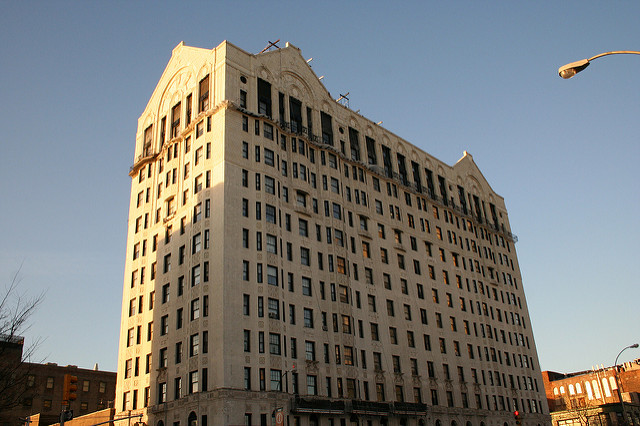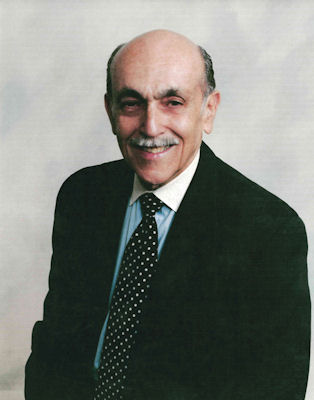
by Stanley Turkel, CMHS
Hotel History: Hotel Theresa, “The Waldorf of Harlem”
Fidel Castro’s recent death brings to mind his visit to New York City. On September 18, 1960, four months before the United States severed diplomatic relations with Cuba, Fidel Castro arrived in New York City for the 15th session of the United Nations General Assembly. He and his staff first checked into the Shelburne Hotel at Lexington Avenue and 37th Street. When the Shelburne demanded $10,000 for alleged damage that included cooking chickens in their rooms, the Castro entourage moved to the Hotel Theresa in Harlem. Castro’s group rented eighty rooms for a total of $800 per day. The Theresa was the beneficiary of worldwide publicity when Nikita Khrushchev, the premier of the Soviet Union; General Abdul Nasser, president of Egypt; Jawaharlal Nehru, the prime minister of India; and Malcom X, all visited Castro there.
In the longest speech ever delivered at the United Nations, Castro transitioned seamlessly from his hotel experience to the discrimination faced by North American blacks to the broader evils of “imperialist financial capital” and the “colonial yoke”.
At the end of 1960, presidential candidate John F. Kennedy made a campaign stop at the Hotel Theresa with Jacqueline Kennedy, Congressman Adam Clayton Powell Jr., Senator Herbert Lehman, Governor Averill Harriman, Mayor Robert Wagner and Eleanor Roosevelt. “I am delighted to come and visit,” said Kennedy. “Behind the fact of Castro coming to this hotel, Khrushchev coming to visit Castro, there is another great traveler in the world, and that is the travel of a world revolution, a world in turmoil. I am delighted to come to Harlem and I think the whole world should come here and the whole world should recognize that we all live right next to each other, whether here in Harlem or on the other side of globe.”
The Hotel Theresa opened in 1913 on 125th Street and Seventh Avenue in Harlem and closed its doors as a hotel in 1970. It was built by German-born stockbroker Gustavus Sidenberg and named for his recently-deceased wife. Coincidentally, Sidenberg’s second wife was also named Theresa. Architects George and Edward Blum were trained at the famous Ecole des Beaux-Arts in Paris and they designed a full-blockfront all-white apartment hotel, 13 stories high with 300 guestrooms. Like its façade, the newly-opened Hotel Theresa had an all-white clientele and staff for its first twenty-eight years. In 1940, reflecting the changing population of Harlem, the hotel was acquired by Love B. Woods, an African American businessman who accepted all races, hired a black staff and management. The Hotel Theresa was integrated when most mid-Manhattan hotels wouldn’t accept blacks. They could perform at the clubs, hotels and theaters in mid-Manhattan but couldn’t sleep in the hotel rooms or eat in their restaurants. Black America’s most famous stars: Josephine Baker, Ray Charles, Jimi Hendrix, Louis Armstrong, Dorothy Dandridge, Duke Ellington, Nat King Cole, Lena Horne and Count Basie had to go to Harlem for a night’s sleep. For many blacks the existence of the Hotel Theresa’s luxurious rooms, bars and swank shops was regarded as a sign that they had finally arrived, at least in Harlem. The hotel became known as the “Waldorf of Harlem.”
Seventh Avenue and 125th Street was called the Great Black Way. The neighborhood contained the Salem Methodist Church; the studio of James Van Der Zee, Harlem’s most famous photographer; the African Memorial National Bookstore; the mafia-owned Diamond Jewelry Store; the M. Smith Photo Studio; the Apollo Theater; Blumstein’s Department Store; Frank’s Restaurant; Harlem Opera House; Oscar Hammerstein’s Play House; Hartz and Seamon’s Music Hall; the Cotton Club; Mike’s Place; Savoy Ballroom; Nest Club; Smalls Paradise and The Club Baron.
In 1940, the following announcement appeared in the New York Age:
Harlem Hotel Seeks Negro Trade; Picks Manager: The Hotel Theresa at Seventh Avenue and 125th Street, which catered to white patronage for several years, has changed its policy as of March 20 and will cater to both races, under Negro management with a Negro staff, according to an announcement by Richard Thomas, publicity manager of the hotel. In carrying out its new policy for the accommodation of Negroes and whites, the Gresham Management Company, operators of the Theresa, appointed Walter Scott as the hotel’s manager. Extensive renovations and improvements of the service and facilities of the hotel have been undertaken. A staff of 80 persons has been employed.
The African American General Manager Walter Scott had been the business manager at the Harlem YMCA on 135th Street. A graduate of New York University and a World War I veteran, Scott had worked as a bellhop and waiter on the Hudson River Dayline boats. Early in April 1940, Scott and his wife Gertrude and their sixteen year-old daughter, Gladys moved into a six-room suite on the tenth floor.
In 1941, heavyweight champion Joe Louis attracted 10,000 fans when he stayed at the Hotel Theresa after a victory at the Polo Grounds. Soon thereafter, entrepreneur John H. Johnson was a guest at the Theresa when he started a new pocket-size magazine called Negro Digest and, in 1945, Ebony which was followed by Jet in 1951. After splitting with the Nation of Islam, Malcolm X rented offices at the hotel for his Organization of Afro-American Unity.
In 1948, when GM Walter Scott resigned because of illness, Gresham Management hired William Harmon Brown as resident manager. Brown graduated from Howard University where he had earned a National Youth Administration scholarship, funded by a New Deal program. President Bill Clinton’s commerce secretary Ron Brown, the manager’s son, grew up in the hotel. U.S. Congressman Charles Rangel (D. New York) once worked there as a desk clerk. Earlier in 2016 Congressman Rangel retired after serving in the U.S. Congress from 1971-2016.
In 1971, the hotel was converted to an office building with the name Theresa Towers and was declared a landmark in 1993 by New York’s Landmark Preservation Commission.
About Stanley Turkel’s Books
- Great American Hoteliers: Pioneers of the Hotel Industry (2009) During the thirty years prior to the Civil War, Americans built hotels larger and more ostentatious than any in the rest of the world. These hotels were inextricably intertwined with American culture and customs but were accessible to average citizens. Stephen Rushmore writes in the Foreword: "Drawing from more than 40 years of industry experience including managing some of the largest New York City hotels, Turkel captures the spirit of each of these pioneers and relates their achievements to important lessons that we can learn from."
- Built To Last: 100+ Year-Old Hotels in New York (2011) These thirty-two featured hotels have defied the passage of time for a variety of reasons, many explicable, some beyond explanation, all miraculous. Bjorn Hanson, Ph.D. writes in the Foreword: "Stanley Turkel is unique in his passion about the history of the United States lodging industry; he pursues and shares this passion by compiling information about great hoteliers and hotels for articles, updates for his clients, and this, the second of his two hotel books."
- Built To Last: 100+ Year-Old Hotels East of the Mississippi (2013) All the eighty-six hotels featured in this book have unique and singular stories describing their creation, survival and revival. The book contains eighty-six antique postcard illustrations and a Foreword by Joseph McInerney, President and CEO Emeritus of the American Hotel & Lodging Association.
- Hotel Mavens: Lucius M. Boomer, George C. Boldt and Oscar of the Waldorf (2014) Hotel Mavens tells the interesting stories of the following pioneers and the hotels they built and operated:
- Lucius Boomer, one of the most famous hoteliers of his time, was Chairman of the Waldorf-Astoria Hotel Corporation.
- George C. Boldt who was the genius of the original Waldorf-Astoria. It was said of him that he made innkeeping a profession and, more than any man, was the creator of the modern American hotel.
- Oscar of the Waldorf was the superstar of his time and one of the stalwarts who managed both the original and the current Waldorf-Astoria.
Sam Roberts in the New York Times wrote: "Nostalgia for the city's caravansaries will be kindled by Stanley Turkel's Hotel Mavens: Lucius M. Boomer, George C. Boldt and Oscar of the Waldorf". The fact-filled book by Mr. Turkel, an industry consultant, explains, among other things, the history of the hyphen (recently excised) in the name of the Waldorf Astoria, which inspired a mid-block street and even a song.
- Great American Hoteliers Volume 2: Pioneers of the Hotel Industry (2016) Lawrence P. Horwitz, Executive Director, Historic Hotels of America, writes in the Foreword: "This book is an excellent history book with insights into seventeen of the great innovators and visionaries of the hotel industry and their inspirational stories." These important and largely unknown biographies include Stewart William Bainum, Curtis Leroy Carlson, Cecil Burke Day, Louis Jacob Dinkler, Eugene Chase Eppley, Roy C. Kelley, Arnold S. Kirkeby, Julius Manger, Robert R. Meyer, Albert Pick, Jr., Jay Pritzker, Harris Rosen, Ian Schrager, Vernon B. Stouffer, William Cornelius Van Horne, Robert E. Woolley, and Stephen Allen Wynn.
All of these books can be ordered from AuthorHouse by visiting www.stanleyturkel.com and clicking on the book’s title.
If You Need an Expert Hotel Witness:
For the past twenty-four years I have served as an expert witness in more than 40 hotel-related cases.
My extensive hotel operating experience is beneficial in cases involving:
- hurricane damage and/or business interruption cases
- slip and fall accidents
- wrongful deaths
- fire and carbon monoxide injuries
- franchise/franchisor disputes
- management contract disputes
I have been designated as the 2015 and 2014 Historian of the Year by Historic Hotels of America, the official program of the National Trust for Historic Preservation.
Don’t hesitate to call me on 917-628-8549 to discuss any potential litigation support assignments.


